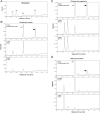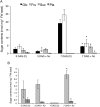Planteose as a storage carbohydrate required for early stage of germination of Orobanche minor and its metabolism as a possible target for selective control
- PMID: 25821071
- PMCID: PMC4449533
- DOI: 10.1093/jxb/erv116
Planteose as a storage carbohydrate required for early stage of germination of Orobanche minor and its metabolism as a possible target for selective control
Abstract
Root parasitic weeds in Orobanchaceae cause serious damage to worldwide agriculture. Germination of the parasites requires host-derived germination stimulants, such as strigolactones, as indicators of host roots within reach of the parasite's radicles. This unique germination process was focused on to identify metabolic pathways required for germination, and to design a selective control strategy. A metabolomic analysis of germinating seeds of clover broomrape, Orobanche minor, was conducted to identify its distinctive metabolites. Consequently, a galactosyl-sucrose trisaccharide, planteose (α-d-galactopyranosyl-(1→6)-β-d-fructofuranosyl-(2→1)-α-d-glucopyranoside), was identified as a metabolite that decreased promptly after reception of the germination stimulant. To investigate the importance of planteose metabolism, the effects of several glycosidase inhibitors were examined, and nojirimycin bisulfite (NJ) was found to alter the sugar metabolism and to selectively inhibit the germination of O. minor. Planteose consumption was similar in NJ-treated seeds and non-treated germinating seeds; however, NJ-treated seeds showed lower consumption of sucrose, a possible intermediate of planteose metabolism, resulting in significantly less glucose and fructose. This inhibitory effect was recovered by adding glucose. These results suggest that planteose is a storage carbohydrate required for early stage of germination of O. minor, and NJ inhibits germination by blocking the supply of essential glucose from planteose and sucrose. Additionally, NJ selectively inhibited radicle elongation of germinated seeds of Orobanchaceae plants (Striga hermonthica and Phtheirospermum japonicum). Thus, NJ will be a promising tool to develop specific herbicides to the parasites, especially broomrapes, and to improve our understanding of the molecular mechanisms of this unique germination.
Keywords: Broomrapes; metabolomics; nojirimycin; planteose; root parasitic weeds; seed germination; selective control; sugar metabolism..
© The Author 2015. Published by Oxford University Press on behalf of the Society for Experimental Biology.
Figures








Similar articles
-
Involvement of α-galactosidase OmAGAL2 in planteose hydrolysis during seed germination of Orobanche minor.J Exp Bot. 2022 Apr 5;73(7):1992-2004. doi: 10.1093/jxb/erab527. J Exp Bot. 2022. PMID: 34850875 Free PMC article.
-
The effect of nojirimycin on the transcriptome of germinating Orobanche minor seeds.J Pestic Sci. 2020 Nov 20;45(4):230-237. doi: 10.1584/jpestics.D20-057. J Pestic Sci. 2020. PMID: 33304192 Free PMC article.
-
Effect of fungal and plant metabolites on broomrapes (Orobanche and Phelipanche spp.) seed germination and radicle growth.J Agric Food Chem. 2014 Oct 29;62(43):10485-92. doi: 10.1021/jf504609w. Epub 2014 Oct 16. J Agric Food Chem. 2014. PMID: 25272312
-
Plants that attack plants: molecular elucidation of plant parasitism.Curr Opin Plant Biol. 2012 Dec;15(6):708-13. doi: 10.1016/j.pbi.2012.07.004. Epub 2012 Aug 13. Curr Opin Plant Biol. 2012. PMID: 22898297 Review.
-
Strigolactones and root infestation by plant-parasitic Striga, Orobanche and Phelipanche spp.Plant Sci. 2011 Mar;180(3):414-20. doi: 10.1016/j.plantsci.2010.11.007. Epub 2010 Nov 23. Plant Sci. 2011. PMID: 21421387 Review.
Cited by
-
The composition of Australian Plantago seeds highlights their potential as nutritionally-rich functional food ingredients.Sci Rep. 2021 Jun 16;11(1):12692. doi: 10.1038/s41598-021-92114-1. Sci Rep. 2021. PMID: 34135417 Free PMC article.
-
Enhanced production of nojirimycin via Streptomyces ficellus cultivation using marine broth and inhibitory activity of the culture for seeds of parasitic weeds.J Pestic Sci. 2017 Nov 24;42(4):166-171. doi: 10.1584/jpestics.D17-036. J Pestic Sci. 2017. PMID: 30363106 Free PMC article.
-
Seed Metabolome Analysis of a Transgenic Rice Line Expressing Cholera Toxin B-subunit.Sci Rep. 2017 Jul 12;7(1):5196. doi: 10.1038/s41598-017-04701-w. Sci Rep. 2017. PMID: 28701756 Free PMC article.
-
The Effect of 10 Crop Plants That Served as Hosts on the Primary Metabolic Profile of the Parasitic Plant Phelipanche aegyptiaca.Metabolites. 2022 Nov 29;12(12):1195. doi: 10.3390/metabo12121195. Metabolites. 2022. PMID: 36557233 Free PMC article.
-
Comparative Metabolomics of Early Development of the Parasitic Plants Phelipanche aegyptiaca and Triphysaria versicolor.Metabolites. 2019 Jun 13;9(6):114. doi: 10.3390/metabo9060114. Metabolites. 2019. PMID: 31200467 Free PMC article.
References
-
- Akiyama K, Matsuzaki K, Hayashi H. 2005. Plant sesquiterpenes induce hyphal branching in arbuscular mycorrhizal fungi. Nature 435, 824–827. - PubMed
-
- Aoki T, Hatanaka S. 1991. Effect of plant growth of a sugar analogue, 1,4-dideoxy-1,4-iminoarabinitol: inhibition of invertase activity and sucrose transport in lucerne seedlings. Phytochemistry 30, 3197–3201.
-
- Aliferis KA, Chrysayi-Tokousbalides M. 2010. Metabolomics in pesticide research and development: review and future perspectives. Metabolomics 7, 35–53.
-
- Aliferis KA, Jabaji S. 2011. Metabolomics – a robust bioanalytical approach for the discovery of the modes-of-action of pesticides: a review. Pesticide Biochemistry and Physiology 100, 105–117.
-
- Aly R. 2007. Conventional and biotechnological approaches for control of parasitic weeds. In Vitro Cellular & Developmental Biology - Plant 43, 304–317.
Publication types
MeSH terms
Substances
LinkOut - more resources
Full Text Sources
Other Literature Sources

